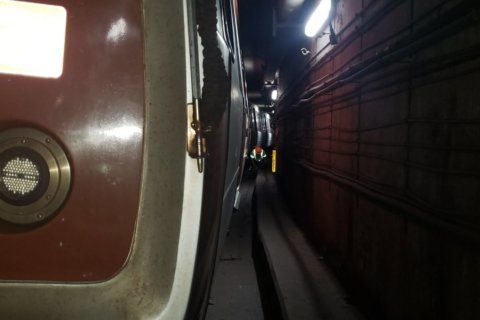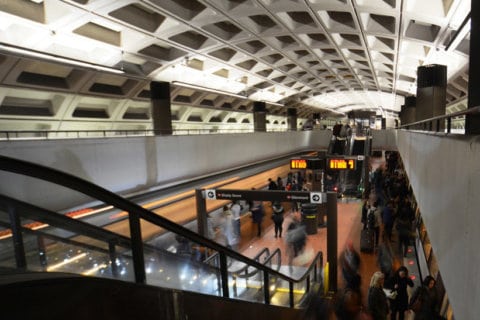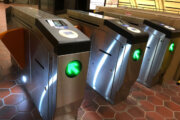Metro may not return to smoother, more efficient automatic train operation for five to seven years, since the current system may be scrapped before it ever gets reactivated.
“As far as we know, they are not going to be turning that back on any time in the next five years,” Sharmila Samarasinghe, the chief operating officer of the Washington Metrorail Safety Commission, said Tuesday.
Metro suspended automatic train operation after the 2009 Fort Totten crash, even though the system was not the cause of the crash. Metro spent years fixing the signaling system, which allowed a train to essentially become invisible to controllers and the train that came speeding up from behind.
Over the last decade, Metro has run only a handful of trains carrying riders in the fully automatic mode the system is designed for.
Metro has never publicly and officially ruled out a return to fully automatic operations under the current system, but has suggested for several years that it’s not a priority.
“Following an analysis, Metro prioritized projects that matter more to safety and reliability,” spokesman Ian Jannetta said in an email Tuesday.
He had no information on whether or when automatic operations might resume — the same public position Metro has held for the last two years.
Metro documents at that time suggested to the Metro Board that the major benefits of automatic operations to riders, and the reduction in maintenance, could be outweighed by concerns about whether system upgrades and new safety rules implemented since 2009 are compatible with the automatic operations system.
The automatic operations can provide smoother, more consistent rides with more even spacing of train arrivals at stations. Automatic operations also require less staffing in some areas among other benefits.
The short-lived attempt to restore automatic door operations over the summer provided a bad omen for the hopes for smoother automatic rides any time soon. The idea was for automatic doors to open when a train is properly parked in a station, without waiting five seconds or more for an operator confirm the correct side of the train and then manually open the doors. While doors were opening properly at most stations, they were unexpectedly closing automatically.
The current automatic operations system is the same as when Metro opened more than 40 years ago, and could need additional fixes to get back up and running, given that it hasn’t been active for a decade.
“They are trying to be more judicious in what they decide, as a capital investment, as well, because it’s pointless them investing in a technology that’s outdated … and might not even have the manufacturers to manufacture the component parts and the equipment associated with it,” Samarasinghe said.
Metro is continuing to look into a more modern signal and train control system that would be entirely different from the current system, which monitors the position of trains based on set segments of track.
“They are doing that in an earnest and very judicious and very reflective manner, so that is not off the table, but while they’re working on it — and that is about five to seven years down the road — we still need them to be making sure that they are running a safe Metrorail operation,” Samarasinghe said.
Comes up after October crash
Questions about automatic operations came up after Tuesday’s commission meeting because of findings following an Oct. 7 crash near Farragut West. A train operator potentially distracted by a cellphone moved his train without permission, but a number of problems Metro has already known about but yet to fully address were also involved.
The issues raised Tuesday included a need to focus on improvements to training and certification for train operators, supervisors and rail controllers; improved rail control center staffing; better plans to prevent fatigue and overwork among operators and staff; more disciplined radio use, and preventing pressure on train operators to rush down the line.
The commission hopes issuing the findings again, with a focus on near-term fixes for how things are actually operating today, could lead to more immediate improvements while Metro considers how to complete longer-term changes that might require more expensive or extensive work.
In the crash, a train operator moved without permission from the Rail Operations Control Center, Samarasinghe said. All Metro systems appeared to have been working properly at the time of the crash.
An effort to use more technology to prevent train operators from moving without permission is not foolproof, as demonstrated by separate, less-serious incidents over the last two months. Still, a requirement to hit extra buttons before moving a train that is receiving commands to stop is set to be rolled out by May across Metro’s railcar fleet.
The commission also wants more monitoring of train operators’ and rail controllers’ compliance with rules for moving trains when they show “zero speed commands.”
The commission is also worried about a lack of standardized speed limits for trains as they approach stations.
“There’s no rule that is present that instructs them, ‘You need to approach the station at this speed,’” Samarasinghe said, ” … and especially if you are a new operator or new to that part of the territory, you really don’t have a very good sense of how fast you should be approaching a station.”
More trains are overshooting station platforms this year than last; at least 55 times in 2019, a train has stopped with at least one door beyond the end of the station platform.
The commission and Metro have scheduled a “station overrun summit” next Tuesday.
Metro initially created a station overrun working group earlier this year in response to the commission’s concerns, but that group met only twice and has not met for four months, Samarasinghe said.
If automatic operations are not coming back any time soon, the commission recommended Metro set a designated speed that trains are supposed to approach stations. That would particularly help new train operators or those working on a different line than usual.
The commission also suggested clearer definitions of what qualifies as a station overrun and possible internal Metro review boards to discuss reasons for incidents and ways to prevent them in the future.
Other action plans needed
The commission is also directing Metro to change the design of visors on the new 7000 Series trains to keep them from blocking driver-facing cameras. The changes will also need to be incorporated into Metro’s new trains, the 8000 Series cars, which are due to arrive within the next decade.
Metro also has a new requirement to plan for even more data-driven inspection, maintenance and modernization plans.
Both the commission and Metro are working to improve future crash investigations. The organizations met to consider ways to streamline investigative activity.
The official report on the crash and several other incidents could be adopted at the commission’s next meeting, set for late January.






